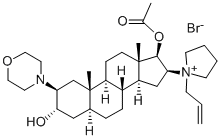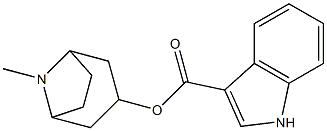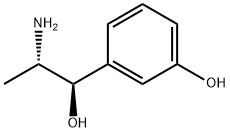Dexmedetomidine
- Empirical Formula: C13H16N2
- Molecular Weight: 0
- MDL number: MFCD00880557
- Update Date: 2023-04-23 13:52:06
What is Dexmedetomidine?
Description
Dexmedetomidine has an eight times increased affinity for the α2-receptor compared with clonidine and therefore produces less cardiovascular instability at comparable doses.
The Uses of Dexmedetomidine
Dexmedetomidine is principally used as a sedative in mechanically ventilated patients in ICU. I t is particularly useful in those patients with delirium.
The Uses of Dexmedetomidine
Dexmedetomidine is the S -enantiomer of the veterinary anaesthetic medetomidine. It has highly selective activity at α2 adrenoceptors (1600 : 1 α2 : α1) and eight times more affinity than clonidine for this site. D exmedetomidine is licenced in the UK for i.v. sedation of adult patients in intensive care, although there is off-licence use, such as for procedural sedation during an awake craniotomy.
brand name
Precedex (Hospira).
Mechanism of action
Dexmedetomidine is metabolised via hepatic glucuronidation, and clearance is reduced in patients with liver impairment. Very li??le unchanged drug reaches the urine, but 95% of degradation products are excreted this way (4% in faeces). There is a theoretical possibility of accumulation of metabolites in patients with renal failure, but toxicity has not been described because active metabolites of dexmedetomidine have not been identified at present.
Pharmacokinetics
Dexmedetomidine is freely soluble in water and has a pKa of 7.1. The pharmaceutical formulation is a clear, colourless preservative-free solution with a pH of 4.5–8. Protein binding of dexmedetomidine is 94%, with negligible displacement by drugs commonly used in anaesthetic and I CU practice. The elimination half-life is approximately 2h and the steady-state volume of distribution is 118 l. There are no significant differences in the pharmacokinetic profile in the elderly, but an enhanced clinical response is seen.
Veterinary Drugs and Treatments
In the USA, dexmedetomidine for dogs is approved for use as a sedative
and analgesic to facilitate clinical examinations, clinical procedures,
minor surgical procedures, and minor dental procedures, and
as a preanesthetic to general anesthesia.
In Europe, dexmedetomidine is additionally indicated for use in
cats similarly to dogs above, but when used as premed it is indicated
for use prior to ketamine general anesthesia.
Properties of Dexmedetomidine
| Melting point: | 144-147°C |
| storage temp. | -20°C Freezer |
| solubility | Chloroform (Slightly), Methanol (Slightly) |
| form | Solid |
| color | White to Off-White |
Safety information for Dexmedetomidine
Computed Descriptors for Dexmedetomidine
New Products
4,4-Difluoropiperidine hydrochloride tert-butyl 9-methoxy-3-azaspiro[5.5]undecane-3-carboxylate Indole Methyl Resin N-Isopropylurea N,N-Dicyclohexylcarbodiimide(DCC) MELDRUMS ACID 5-METHYLISOXAZOLE-4-CARBOXYLIC ACID Magnessium Bis glycinate Zinc ascorbate 1-bromo-2-butyne 2-acetamidophenol 9(10H)-anthracenone Erythrosin B, 4-Piperidinopiperidine 2-((4-morpholinophenylamino) (methylthio) methylene) malononitrile 2,4-dihydroxybenzaldehyde 3-(4-morpholinophenylamino)-5-amino-1H-pyrazole-4-carbonitrile Methyl 2-methylquinoline-6-carboxylate 2,6-dichloro-4-nitropyridine 4-Bromo-2-chlorobenzonitrile 2-(benzylamino)acetic acid hydrochloride 4-(tert-Butoxycarbonylamino)but- 2-ynoic acid 3,4-dihydro-2H-benzo[b][1,4]dioxepine 1-Phenyl-1-cycloprppanecarboxylicacidRelated products of tetrahydrofuran
You may like
-
 3-(4-amino-1-oxoisoindolin-2-yl)-1-methylpiperidine-2,6-dione 98%View Details
3-(4-amino-1-oxoisoindolin-2-yl)-1-methylpiperidine-2,6-dione 98%View Details -
 1-methylindoline-2,3-dione 98%View Details
1-methylindoline-2,3-dione 98%View Details
2058-74-4 -
 614-19-7 98%View Details
614-19-7 98%View Details
614-19-7 -
 3112-85-4 Methyl phenyl sulfone 98%View Details
3112-85-4 Methyl phenyl sulfone 98%View Details
3112-85-4 -
 20677-73-0 (2,2-diethoxyethyl)methylamine 98%View Details
20677-73-0 (2,2-diethoxyethyl)methylamine 98%View Details
20677-73-0 -
 3-(4-(hydroxyamino)-1-oxoisoindolin-2-yl)piperidine-2,6-dione 98%View Details
3-(4-(hydroxyamino)-1-oxoisoindolin-2-yl)piperidine-2,6-dione 98%View Details -
 57381-49-4 2-bromo-4-chlorobenzonitrile 98%View Details
57381-49-4 2-bromo-4-chlorobenzonitrile 98%View Details
57381-49-4 -
 4,6-dichloropyrimidine-5-carbaldehyde 98%View Details
4,6-dichloropyrimidine-5-carbaldehyde 98%View Details
5305-40-8



